
The Future of School Infrastructure: A Leap Towards Sustainability
In a groundbreaking move for educational institutions across the United States, North Shore School District 112 in Highland Park, Illinois, has adopted a pioneering geothermal heating and cooling system. Unveiled by Trane Technologies, this dynamic closed-loop geothermal (DCL) system is the first of its kind deployed in the nation, representing a significant advancement in sustainable building practices for schools.
Economic and Environmental Benefits of Geothermal Systems
As concerns around energy costs and environmental impacts escalate, educational facilities are exploring innovative solutions. This $6.7 million project, funded through a mix of local, state, and federal incentives that cover up to 50% of costs, is set to provide hope not just for improved comfort, but also for substantial cost reductions. Trane Technologies anticipates that the new system could reduce the elementary school’s carbon emissions by approximately 30%. Such metrics are crucial for school districts looking to balance budget constraints while pushing for greener alternatives.
How a Closed-Loop Geothermal System Works
The innovative DCL system operates by using the robust heat transfer properties of flowing groundwater, efficiently absorbing and rejecting heat, which allows for consistent temperature regulation throughout the year. Unlike traditional systems, its compact design necessitates a smaller surface footprint, making it particularly suitable for urban and suburban settings where land use is often at a premium. This approach simplifies installation while maximizing utility.
Broader Implications for the Construction Industry
The successful implementation of this geothermal system sets a compelling precedent for other educational institutions and commercial properties. Across the country, colleges and universities, from Colorado to Vermont, are increasingly studying and developing similar geothermal infrastructure to enhance heating and cooling efficiency. Such moves highlight a growing trend towards sustainability in design, resonating with environmentally conscious stakeholders.
A Call for Future Projects
As the global focus shifts towards sustainability, private developers, business owners, and facility managers must consider integrating geothermal systems into their construction and renovation projects. The financial and environmental dividends of implementing such technologies are aligning perfectly with market needs. Future investments directed towards geothermal and other sustainable practices are not merely beneficial—they are becoming essential for responsible leadership in the commercial sector.
Final Thoughts: Pioneering Sustainable Change
The deployment of the geothermal system at Ravinia Elementary School signifies a notable shift in how educational facilities address both comfort and environmental responsibility. As more institutions recognize the advantages of such dynamic energy systems, the construction industry is poised to evolve markedly. For stakeholders involved in commercial construction and property development, it’s time to assess how innovations like geothermal technology can enhance operations and lead to significant cost savings.
 Add Row
Add Row  Add
Add 




Write A Comment